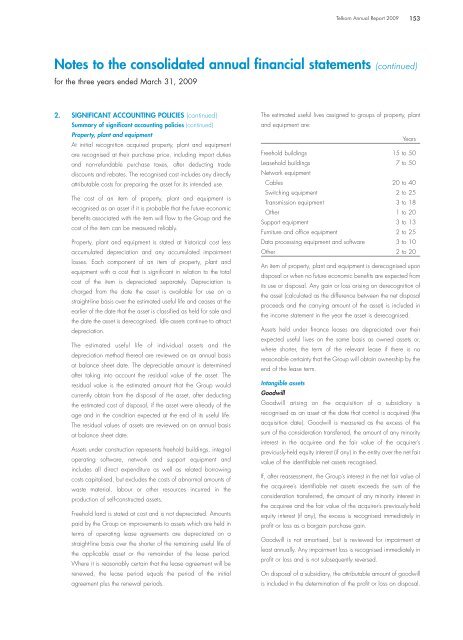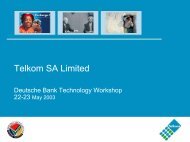Telkom AR front.qxp
Telkom AR front.qxp
Telkom AR front.qxp
You also want an ePaper? Increase the reach of your titles
YUMPU automatically turns print PDFs into web optimized ePapers that Google loves.
2. SIGNIFICANT ACCOUNTING POLICIES (continued)<br />
Summary of significant accounting policies (continued)<br />
Property, plant and equipment<br />
At initial recognition acquired property, plant and equipment<br />
are recognised at their purchase price, including import duties<br />
and non-refundable purchase taxes, after deducting trade<br />
discounts and rebates. The recognised cost includes any directly<br />
attributable costs for preparing the asset for its intended use.<br />
The cost of an item of property, plant and equipment is<br />
recognised as an asset if it is probable that the future economic<br />
benefits associated with the item will flow to the Group and the<br />
cost of the item can be measured reliably.<br />
Property, plant and equipment is stated at historical cost less<br />
accumulated depreciation and any accumulated impairment<br />
losses. Each component of an item of property, plant and<br />
equipment with a cost that is significant in relation to the total<br />
cost of the item is depreciated separately. Depreciation is<br />
charged from the date the asset is available for use on a<br />
straight-line basis over the estimated useful life and ceases at the<br />
earlier of the date that the asset is classified as held for sale and<br />
the date the asset is derecognised. Idle assets continue to attract<br />
depreciation.<br />
The estimated useful life of individual assets and the<br />
depreciation method thereof are reviewed on an annual basis<br />
at balance sheet date. The depreciable amount is determined<br />
after taking into account the residual value of the asset. The<br />
residual value is the estimated amount that the Group would<br />
currently obtain from the disposal of the asset, after deducting<br />
the estimated cost of disposal, if the asset were already of the<br />
age and in the condition expected at the end of its useful life.<br />
The residual values of assets are reviewed on an annual basis<br />
at balance sheet date.<br />
Assets under construction represents freehold buildings, integral<br />
operating software, network and support equipment and<br />
includes all direct expenditure as well as related borrowing<br />
costs capitalised, but excludes the costs of abnormal amounts of<br />
waste material, labour or other resources incurred in the<br />
production of self-constructed assets.<br />
Freehold land is stated at cost and is not depreciated. Amounts<br />
paid by the Group on improvements to assets which are held in<br />
terms of operating lease agreements are depreciated on a<br />
straight-line basis over the shorter of the remaining useful life of<br />
the applicable asset or the remainder of the lease period.<br />
Where it is reasonably certain that the lease agreement will be<br />
renewed, the lease period equals the period of the initial<br />
agreement plus the renewal periods.<br />
<strong>Telkom</strong> Annual Report 2009 153<br />
Notes to the consolidated annual financial statements (continued)<br />
for the three years ended March 31, 2009<br />
The estimated useful lives assigned to groups of property, plant<br />
and equipment are:<br />
Years<br />
Freehold buildings 15 to 50<br />
Leasehold buildings<br />
Network equipment<br />
7 to 50<br />
Cables 20 to 40<br />
Switching equipment 2 to 25<br />
Transmission equipment 3 to 18<br />
Other 1 to 20<br />
Support equipment 3 to 13<br />
Furniture and office equipment 2 to 25<br />
Data processing equipment and software 3 to 10<br />
Other 2 to 20<br />
An item of property, plant and equipment is derecognised upon<br />
disposal or when no future economic benefits are expected from<br />
its use or disposal. Any gain or loss arising on derecognition of<br />
the asset (calculated as the difference between the net disposal<br />
proceeds and the carrying amount of the asset) is included in<br />
the income statement in the year the asset is derecognised.<br />
Assets held under finance leases are depreciated over their<br />
expected useful lives on the same basis as owned assets or,<br />
where shorter, the term of the relevant lease if there is no<br />
reasonable certainty that the Group will obtain ownership by the<br />
end of the lease term.<br />
Intangible assets<br />
Goodwill<br />
Goodwill arising on the acquisition of a subsidiary is<br />
recognised as an asset at the date that control is acquired (the<br />
acquisition date). Goodwill is measured as the excess of the<br />
sum of the consideration transferred, the amount of any minority<br />
interest in the acquiree and the fair value of the acquirer’s<br />
previously-held equity interest (if any) in the entity over the net fair<br />
value of the identifiable net assets recognised.<br />
If, after reassessment, the Group’s interest in the net fair value of<br />
the acquiree’s identifiable net assets exceeds the sum of the<br />
consideration transferred, the amount of any minority interest in<br />
the acquiree and the fair value of the acquirer’s previously-held<br />
equity interest (if any), the excess is recognised immediately in<br />
profit or loss as a bargain purchase gain.<br />
Goodwill is not amortised, but is reviewed for impairment at<br />
least annually. Any impairment loss is recognised immediately in<br />
profit or loss and is not subsequently reversed.<br />
On disposal of a subsidiary, the attributable amount of goodwill<br />
is included in the determination of the profit or loss on disposal.




